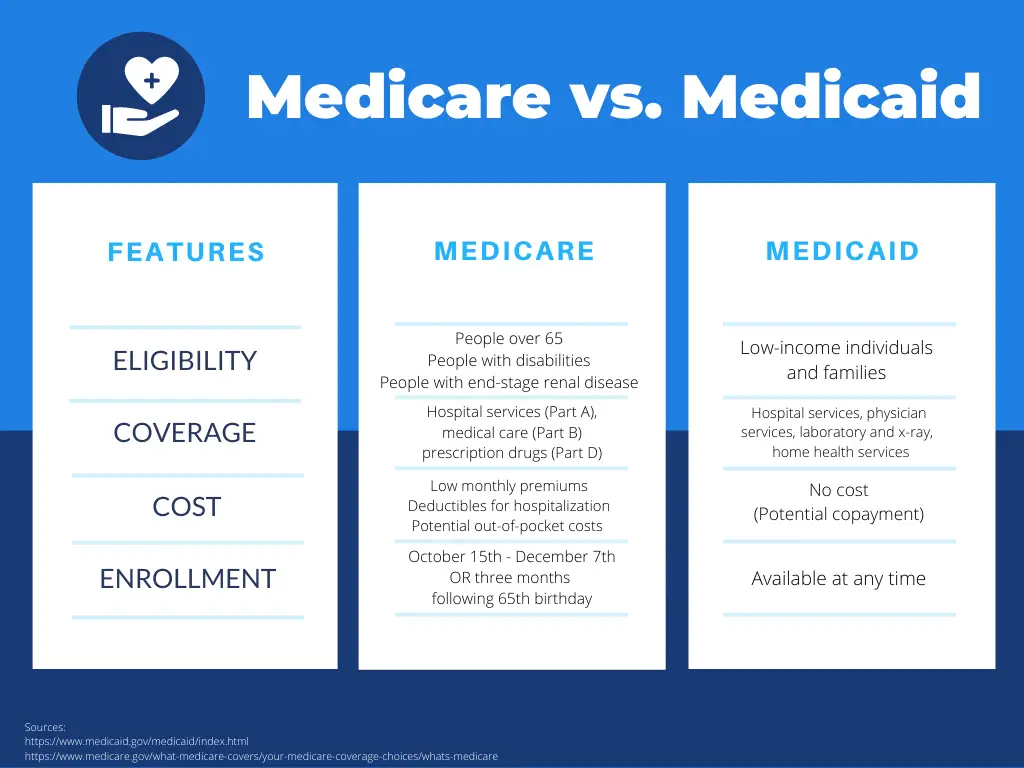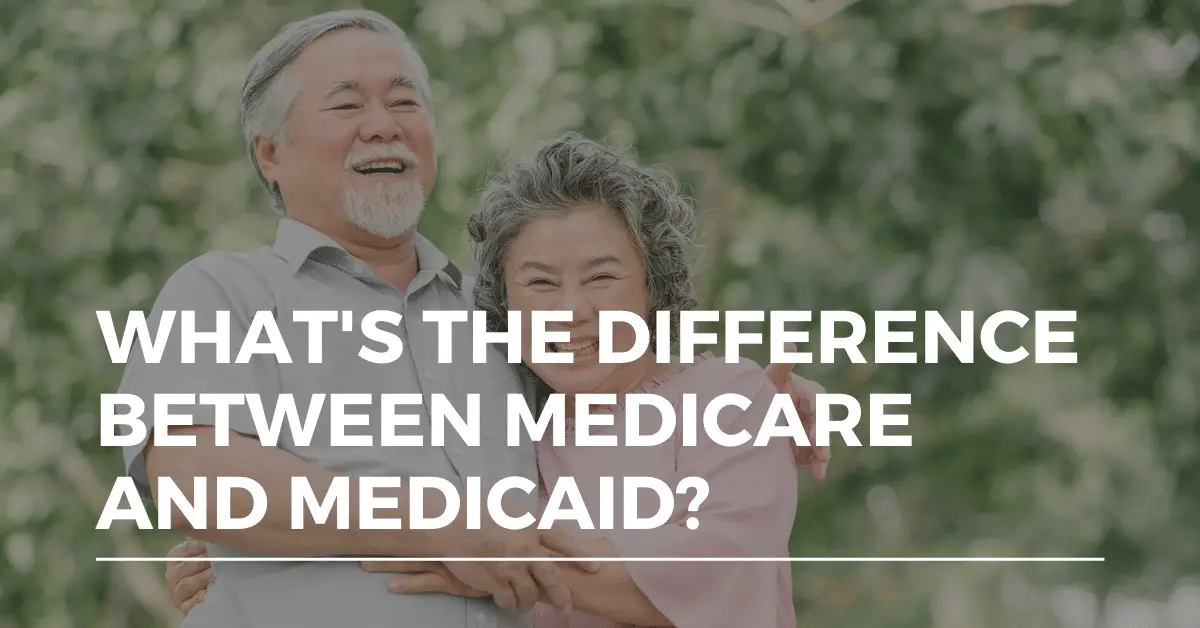Medicare and Medicaid are both government-funded health insurance plans. You may have heard the terms used interchangeably. However, these programs are not the same.
So, what’s the difference between Medicare and Medicaid?
This guide will compare the two plans by breaking down several categories:
- Basic definitions
- Eligibility
- Coverage
- Cost
- Enrollment
By understanding the basic differences between the two programs, you can better prepare yourself or a loved one for enrollment.

Basic Definitions
We’re going to cover a lot of details across both Medicare and Medicaid, but the best way to begin is to clearly define what each of these programs is in the most basic of terms.
Basic Definition of Medicare
Medicare is a federally-funded health insurance program for the following groups:
- People over 65
- Certain younger individuals with disabilities
- People with end-stage renal disease
Various parts of the Medicare program provide coverage across different services. For this reason, the system is split into three distinct areas:
- Medicare Part A
- Medicare Part B
- Medicare Part D
Medicare Part A offers coverage for any instance in which you are hospitalized. This hospital insurance affords you care across skilled nursing facilities, hospice, and even some home health care.
With Medicare Part B, participants receive general medical insurance that covers services like doctor visits, outpatient care, various medical supplies, and preventative care.
Original Medicare includes both parts A and B and covers the next section, which is Part D.
Medicare Part D handles everything related to prescription drugs. Recipients secure financial aid to cover the costs of drugs, including several of the physician-recommended shots and vaccines.
There is also a Part C, which is referred to as Medicare Advantage. Medicare Advantage is provided through private insurance companies and combines the types of coverage usually offered under Parts A, B, and D.
However, Part C also delivers additional benefits, including areas like dental, vision, and popular health initiatives. Sometimes, these initiatives cover expenses like transportation costs.
Each Medicare Advantage plan is carefully evaluated by the Centers for Medicare and Medicaid Services, so you can easily compare and contrast before choosing a private insurer.
Basic Definition of Medicaid
Medicaid is another health coverage program that is funded by both the states and the federal government.
Unlike Medicare, which is limited to mainly the elderly population, Medicaid offers health insurance to:
- Low-income adults
- Pregnant women
- Elderly adults
- Children
- Individuals with disabilities.
In general, Medicaid is focused on the low-income population of the country, and it gives its subscribers similar protections and coverage as an employer would with its plans.
While you can receive Medicaid benefits through the state, you can also do so through a private insurer. The latter choice is the more popular one because it gives you a more comprehensive range of coverage options.
Even when you receive Medicaid through a private insurer, your provider must include specific plan components as required by the federal government. Some of these benefits include:
- Hospitalizations
- Home Health Care
- Physician Appointments
- Labs and X-Rays
- Maternity Care
- Pediatric
- Preventative Care
- Child Dental Care
The purpose of this program is to allow those with low annual income access to quality medical care.
Eligibility
As far as eligibility goes, there are some significant differences between Medicare and Medicaid. However, there is one exception where you could be eligible for both.
Because Medicare and Medicaid are both readily available to those with disabilities, you may be eligible for either one.
If you are on Social Security Disability insurance, or SSDI, then you are eligible for Medicare. In order to actually receive Medicare benefits, you must have been on SSDI for at least two years.
However, you can access Medicaid immediately if you have been approved for Supplemental Security Income, or SSI.
Medicare
The main qualifier for receiving Medicare benefits is reaching the age of 65. Beyond this, you can also access Medicare if you are a younger person with a disability, or you have End-Stage Renal Disease (permanent kidney failure).

Most elderly adults age 65 or older can receive premium-free Medicare if they or their spouse paid Medicare taxes for a minimum of 10 years with the following qualifiers:
- You are currently obtaining retirement benefits from either Social Security or the Railroad Retirement Board.
- You or your spouse were/are a government employee with Medicare coverage.
- You may start receiving Social Security or Railroad Retirement benefits but haven’t filed for them yet.
However, if neither you nor your spouse paid Medicare taxes, you can still purchase Part A Medicare insurance. Most individuals do not pay a premium for Part A of Medicare, but everyone pays a premium for Part B as an added service.
Additionally, everyone on Medicare has access to prescription drug coverage, or Part D.
Medicaid
While eligibility for Medicare is based on age or disability, eligibility for Medicaid is based mostly on income. This joint federal and state program also collaborates with the Children’s Health Insurance Program, or CHIP, and is available to both children and adults, families, and singular individuals.
Medicaid provides services to low-income families, pregnant women and children, and those who receive Supplemental Security Income. These are requirements at the federal level, but each state may have additional coverage options for more groups of people.
Because of the Affordable Care Act of 2010, eligibility for children reaches at least 133% of the federal poverty line – though many states will cover children in households with higher incomes.
Furthermore, adults with income at or less than 133% of the federal poverty line are eligible for Medicaid. Several states will also extend their coverage to adults with higher incomes than this, but you must check with the state that you live in.
All Medicaid eligibility is established through Modified Adjusted Gross Income, or MAGI. This methodology is used to identify all financial eligibility across Medicaid, CHIP, premium tax credits, and cost-sharing reductions.
Beyond financial eligibility, all Medicaid recipients must be residents of the state in which they are getting their Medicaid benefits. They also must be US citizens or expressly qualified non-citizens. Finally, some eligibility groups may be limited by factors such as age, pregnancy, or parenting status.
Coverage
Coverage is another area where you can note several key differences between Medicare and Medicaid.
Medicare
Depending on the area in which you live, Medicare can cover an extensive list of medical tests, procedures, services, and items. Additionally, the different parts of Medicare offer varying coverage options.
With Medicare Part A, you have coverage in terms of hospital care. Everyone who is eligible for Medicare has Part A, whether they are eligible premium-free or must buy it. This coverage includes nursing care, hospital services, hospice, and home care.
Part B covers various types of outpatient care, such as doctor’s appointments and other regular treatment and check-ups. Part D, which is included in Parts A and B, covers your prescription drugs according to federal guidelines.
Medicare Part C is where things get a little tricky. Part C falls under private insurers. While Part C will always include the same benefits as Parts A and B, it may also extend further to cover additional benefits like dental and vision.
For a comprehensive list of specific tests, items, and services covered in all locations, visit this Medicare website page.
Medicaid

The federal and state governments fund Medicaid jointly, so services and benefits can vary from state to state. Different states will administer various programs and have the independence to determine the type, amount, scope, and duration of services – as long as they remain within the federal guidelines.
At the federal level, all Medicaid programs must offer the following:
- Hospital Services
- Physician Services
- Laboratory and X-Ray
- Home Health Services
Some of the optional services that your state may or may not provide under Medicaid include physical therapy, occupational therapy, prescription drugs, and case management.
Medicaid is also the largest payer for mental health and behavioral health services. And, under Medicaid, states must provide child dental services. Other benefits can include early and periodic screening, prevention, and telemedicine.
Cost
Since Medicaid is geared towards low-income families and households, their beneficiaries typically do not have to pay anything towards their covered services. In some cases, individuals may have to pay a copayment – these payments are usually minimal, though.
Medicare is different in that members of these services must pay part of their cost through deductibles. Deductibles are typically limited to hospitalizations, while other coverage areas are paid through very low monthly premiums. The latter includes services such as preventative care or doctor’s appointments.
Additionally, Medicare recipients may accrue costs for certain out-of-pocket expenses, including prescription drugs. A Medicare plan can cost anywhere from $0 to $100 in monthly premiums with deductibles of up to $10,000.
Enrollment
Knowing how and when to enroll in Medicare or Medicaid is critical information for both you and your loved ones. There are different steps in each process.
Medicare
Medicare offers open enrollment from October 15 through December 7. During this time period, you can sign up for your plan or make changes to your existing plan.
Additionally, once you turn 65, you don’t have to wait for the open enrollment period. You have three months following your 65th birthday to sign up for your Medicare plan.
Before signing up or changing your plan, there are a few things you need to consider.
Once you turn 65, you may automatically be enrolled in Medicare. If you are not registered automatically, then you have to enroll yourself. You can do this online, and it’s likely that you’ll need to sign up if you’re 65 but not receiving Social Security.
You may also be eligible for receiving financial assistance with your Medicare costs. Additionally, if you sign up for Medicare Part B, you can avoid a penalty.
Medicaid
Unlike Medicare, Medicaid does not have a designated enrollment period. You can sign up for Medicaid at any point, regardless of the date. This makes it easier for families with low incomes to sign up and adjust as financially necessary.
Of course, because Medicaid is regulated by the state, you likely won’t have many plan options to choose from. In some ways, that makes the process easier because you don’t have to decide on a plan.
Medicaid also uses targeted enrollment strategies:
- Presumptive Eligibility
- Express Lane Eligibility
- Continuous Eligibility
- Lawfully Residing Immigrant Children and Pregnant Women
These strategies helped states transition from the changes in the Affordable Care Act in 2014 and offer different methodologies in terms of care coverage.
The Presumptive Eligibility strategy assists states in the enrollment of families or individuals who are in need without making them wait for the full application process. This strategy also authorizes specific entities, such as community organizations and schools, to screen for eligibility, help father documents, and complete the application process.
Express Lane Eligibility functions with agency programs to simplify the enrollment and renewal processes, using information such as Supplemental Nutrition Assistance Program, School Lunch programs, and Temporary Assistance for Needy Families. This strategy may also tap into income tax information for eligibility.
The Continuous Eligibility program allows states to provide children with 12 months of continuous coverage regardless of their family’s financial status or changes. This will enable children to continue to see the same doctor or receive the same care throughout the year.
And finally, the Lawfully Residing Immigrant Children and Pregnant Women strategy lets states offer coverage to both children and pregnant women who lawfully reside in the US.
Key Takeaways
Both Medicare and Medicaid are federal programs that aid specific populations in receiving and benefiting from affordable, high-quality healthcare. The main difference between the two is that Medicare is geared towards elderly adults, while Medicaid assists those in low-income households.
It’s important to note that individuals can be dual-eligible for both Medicare and Medicaid. It’s possible that one program will cover additional costs or services that the other doesn’t, so it may be worth it to enroll in both.
